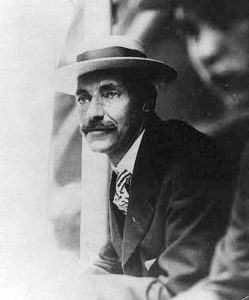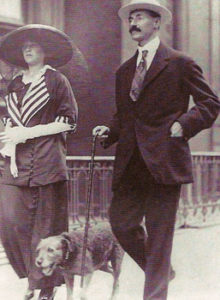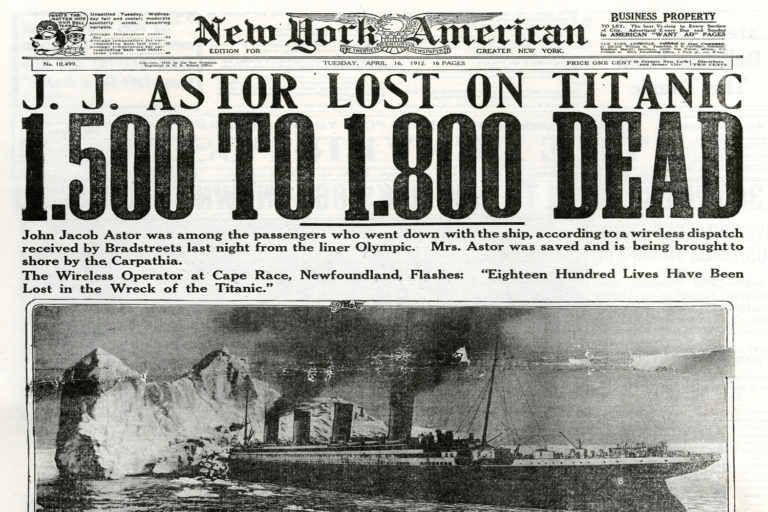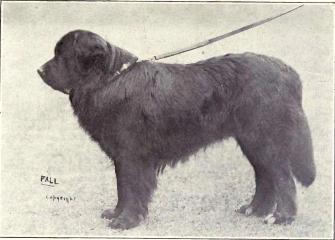"A Costly Thing, Studded With Diamonds": Colonel John Jacob Astor IV
John Jacob Astor--who went by Jack--is easily one of Titanic's most notable passengers.
Wildly wealthy, John Jacob Astor and his second wife--who was 19 years old to his 47--were returning from their honeymoon abroad in Egypt and France, which they were ending early because of her unexpected pregnancy.
The Astors boarded Titanic in Cherbourg, France, on the evening of April 10, 1912. They were accompanied by Mrs. Astor's maid and nurse, Col. Astor's valet, and the Astors's dog, an Airedale named Kitty.

John Jacob Astor IV, circa 1909.
Many of the American elites had recently come to disdain the Astors because of Jack's hasty remarriage to such a young girl.
One of those who didn't pass judgment, however, was fellow First-Class passenger Margaret Brown. She had in fact traveled with the happy couple in Europe, and coincidentally also needed to abbreviate her travels and return to the United States on board the Titanic.

The Washington Times, dated August 3, 1911.
Astor was a Harvard alum; an intelligent man, he was considered eccentric by some.
In addition to the real-estate that comprised his fortune, he had also tried his hand at writing science fiction in the 1890s; he published a novel exploring life on other planets in the faraway year of 2000, called "A Journey in Other Worlds".
He was also fascinated by technological advancements, and was known to invent certain things to make life's little tasks easier--a bicycle brake, for instance--and things to make the world better, such as a more efficient turbine engine.
Jack Astor was also fond of motor cars.

Astor in his motor car, circa 1903. Courtesy of the Library of Congress.
He had served in the United States Army during the Spanish-American War and had thereafter offered his yacht for commission by the United States Navy.
His service, however, was not entirely appreciated by the American public; despite his minimal involvement in combat, he had been rewarded with an honorary promotion to colonel.
It was never the less his chosen form of address for the rest of his life.

Astor in military uniform.
Jack reportedly roused Madeleine immediately after the iceberg strike, assuring her the damage was "not serious."
While queuing on the boat deck for a lifeboat, the young Mrs. Astor reportedly offered her shawl to a third-class passenger, to keep her child warm.
Having grown uncomfortable with the cold while waiting on deck, the Astors went into the gymnasium, taking seats on the mechanical horses. It was during this time that Titanic's First-Class Barber Augustus Weikman found Jack and fellow millionaire George Widener watching some other men have a go at the punching bags.
The Colonel was also reportedly witnessed in the gymnasium slicing open a life-jacket with a pen knife to show his nervous wife the contents therein.

Madeleine Force Astor circa 1915. From the George Grantham Bain Collection, courtesy of Library of Congress.
It was Second Officer Charles Lightoller who refused Jack a seat in Lifeboat 4. Colonel Astor politely indicated that his wife was "in a delicate condition" in an attempt to persuade him otherwise.
But Office Lightoller made no exception.
Colonel Astor reportedly received the refusal with grace, only inquiring as to what lifeboat number it was, in order to reunite with his wife later.
And then, stepping back, the Colonel quietly lit a cigarette with another doomed man.
Conflicting reports persist of Colonel Astor stepping aside, or otherwise giving up his seat to children and selflessly assisting other women into lifeboats. This imagined heroism is a common theme with notable men who died on Titanic; they are, however, often unsubstantiated.

The Astors with their beloved Airedale Terrier, named Kitty.
Mrs. Astor's maid and nurse both survived.
John Jacob Astor IV, as well as his valet Victor Robins, both perished.
John Jacob Astor's body was recovered by the crew of the Mackay-Bennett on April 22, 1912, one of just over three hundred.
The condition of his corpse remains a source of speculation, as it would likely indicate his precise cause of death: hypothermia, drowning, or--as rumor has dictated--the brute injury of being crushed by a falling funnel.
However he met his end, the Titanic's wealthiest victim was labeled as follows.
NO. 124 – MALE – ESTIMATED AGE 50 – LIGHT HAIR & MOUSTACHE.
CLOTHING – Blue serge suit; blue handkerchief with "A.V."; belt with gold buckle; brown boots with red rubber soles; brown flannel shirt; "J.J.A." on back of collar.
EFFECTS – Gold watch; cuff links, gold with diamond; diamond ring with three stones; £225 in English notes; $2440 in notes; £5 in gold; 7s. in silver; 5 ten franc pieces; gold pencil; pocketbook.
FIRST CLASS. NAME- J.J. ASTOR IV
While a great deal of attention was paid to his dazzling effects, there is no mention of damage to Astor's body.
In fact, Mackay-Bennett crewmember Gerald Ross reported the following in his interview with the Philadelphia Evening Bulletin, further demonstrating that, contrary to popular belief, it would appear that John Jacob Astor had not, in fact, been crushed.
I saw the recovery of Col. Astor’s body. Like the others it was floating buoyed by a lifebelt. Both arms extended upwards. The face was swollen, one jaw was injured. His body was clothed in a business suit and tan shoes. His watch, a costly thing, studded with diamonds, was dangling from his pocket. It had stopped at 3:20. Practically all the other watches on bodies we recovered had stopped at 2:10. His watch chain was of platinum and so were the settings of the rings he wore.
Colonel Astor's fame and societal prominence invited much in the way of tall tales and un-truths that persist even today.
For instance, it's been rumored that Astor himself let all the passenger dogs loose from their kennels, although how he would have managed to go from the boat deck to F-deck and back again--all while in the company of his panicked wife and prominent friends--remains to be reasoned out.
And then there's the myth that he was idle at the bar when Titanic struck the iceberg and decided to quip, "I asked for more ice, but this is ridiculous," which appears to be entirely fictitious.

New York American dated April 16, 1912.
Madeleine Astor, now widowed, gave birth to her son in August of 1912.
Named after his late father, he was nicknamed "Jakey" by his mother, and he was sometimes called "the Titanic Baby" by the press.
Madeleine Astor died in 1940, at the age of 46. Her son died in 1992.
SOURCE MATERIAL
[to be appended]







